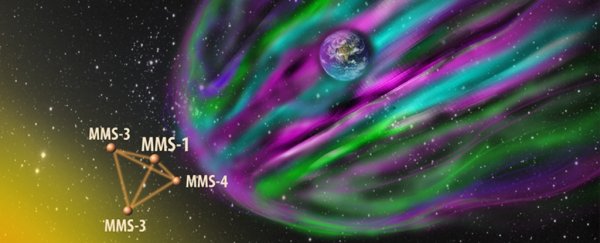Astrophysicists have witnessed tiny ripples forming on Earth's 'bow shock' - the plasma shockwaves produced when solar winds smash into Earth's magnetic field.
While the ripples have long been hypothesised, actually finding them in space has proven a challenge. Now, researchers have been able to study them for the first time, and it could help us to finally understand cosmic rays.
The breakthrough came thanks to thanks to NASA's Magnetospheric MultiScale satellites (MMS).
"With the new MMS spacecraft we can, for the first time, resolve the structure of the bow shock at these small scales," said team leader Andreas Johlander, from the Swedish Institute of Space Physics (IRF).
So, what are these ripples and where do they come from?
Much of the visible matter in the Universe is actually plasma, a hot ionised gas. This plasma can produce shockwaves around other objects in space – such as planets, stars, and supernovae – when it interacts with the magnetic fields around them.
Just imagine it like a wave of water travelling around the bow of a ship, where the water is plasma and the ship's bow is Earth's magnetic field (or magnetosphere), sending the plasma rushing to either side as it displaces it.
These shockwaves are known to act basically like particle accelerators, and shockwaves around supernovae are commonly thought to produce cosmic rays, high energy atoms or particles that travel near the speed of light through space.
But the thing is, we don't really understand exactly how the particles in these shockwaves get so fast.
Based on previously developed mathematical models, researchers think that tiny ripples in these shockwaves might be to blame for this acceleration, though finding and actually witnessing them has been impossible because they are super small and fast, making them hard to spot with traditional technologies.
That is, until now, because the new team was able to witness these ripples inside Earth's bow shock.
To pull off this feat and to analyse these ripples further, the team employed NASA's MMS – a group of four satellites that fly in a tetrahedral formation around Earth's magnetosphere to sample plasma activity.
This represents the first time researchers have been able to successfully witness these ripples, providing proof – once and for all – of their existence other than in mathematical calculations.
But it's just the first step – now we have to figure out how they work.
With further study, the team says that understanding how these ripples in plasma shocks help accelerate and heat particles might shine new light on how cosmic rays form around supernovae.
"These direct observations of shock ripples in a space plasma allow us to characterise the physical properties of the ripples. This brings us one step closer to understanding how shocks can produce cosmic rays," said Johlander.
The team's work was published in Physical Review Letters.
